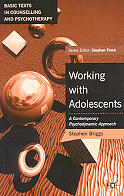(vi hänvisar också till nr 2 och nr 8 av Mellanrummet
där ytterligare referenser återfinns)
Anderson, R. & Dartington,
A. (red.) (1998). Facing it out. Clinical perspectives on adolescent
Disturbance. Tavistock Clinic Series. London: Duckworth & Co. Ltd.
Bornstein, C. & Flanders,
S. (1998). The development of a therapeutic space in a first contact with
adolescents. Journal of Child Psychotherapy, 24(1), 5-35.
Bradley, J. & Dubinsky,
H. (1994). Understanding 15-17 year olds. London: Tavistock Series.
Briggs, S. (2002).
Working with adolescents.
A contemporary Psychodynamic Approach.
Houndmills, Basingstoke: Palgrave
Macmillian.
 Läs recension »»
Läs recension »»
|
 |
Erling, A. & Hwang, P.
(2001). Ungdomspsykologi. Utveckling och livsvillkor. Stockholm:
Natur och Kultur.
Horne, A. (2001). Brief
communications from the edge: psychotherapy with challenging adolescents. Journal
of Child Psychotherapy, 27(1), 3-18.
Miller, L. (2002).
Adolescents with learning disabilities: psychic structures that are not
conductive to learning. Journal of Child Psychotherapy, 28(1),
29-39.
Mondadori, R. (2000). Letting
them go: the short-term treatment of an adolescent at risk. Journal of
Child Psychotherapy, 26(1), 45-68.
Rustin, M., Rhode, M.,
Dubinsky, A. & Dubinsky, H. (1997). Psychotic states in children.
London: Duckworth.
Waddell, M. (2002). The
assessment of adolescents: Preconceptions and realizations. Journal of
Child Psychotherapy, 28(3), 365-382.
Waddell, M. & Bradley, J.
(1994). Understanding 12-14 year olds. London: Tavistock Series.
Williams, G. (red.) (1997).
Internal landscapes and foreign bodies: eating disorders and other
pathologies. Tavistock Clinic Series. London: Karnac.
Williams, G. (red) (2003). Exploring
eating disorders in Adolescence. Vol 1 & 2. The generosity of
acceptance. London: Karnac.
Williams, G. (1994). Understanding
18-20 year olds. London: Tavistock Series.
|
